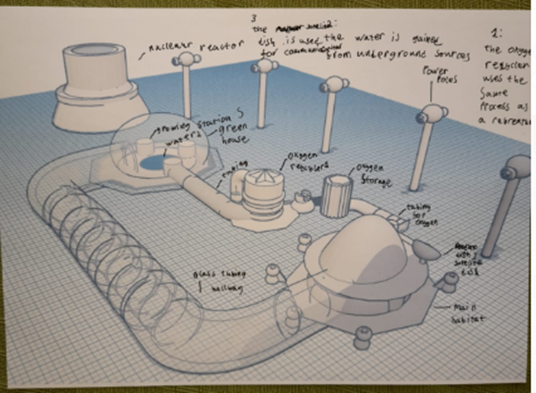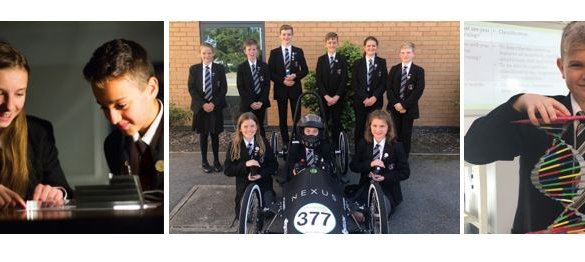Students at Camborne Science and International Academy recently took part in our We Wonder: Mission to Mars reading challenge with almost 750 students from across Year 7 and 8 taking on the challenge.
We established the Reading Champions Challenges with Authors' Licensing and Collecting Society (ALCS) to support whole-school literacy and help teachers encourage a culture of reading for pleasure among their classes with an exciting range of different reading tasks. We are very grateful to Turner & Townsend for the additional funding to support the We Wonder: Mission to Mars reading challenge.
Jade Aldridge, KS3 Science Co-ordinator at Camborne Science and International Academy found the challenge while searching for activities with cross-curricular links to boost students’ engagement with literacy online. She was delighted at the brilliant response her students showed to this particular challenge.
“Our students love a challenge, particularly one that has real life implications. They enjoy finding innovative solutions to real world challenges as it gives meaning to their learning and makes for a wider understanding. STEM challenges can be accessed by all levels of learner if they are scaffolded or pitched in the correct way and students enjoy problem solving.”
Jade Aldridge
She was particularly excited to share this challenge with the pupils as it even made the teachers want to join in. Students found the topic and challenge really fascinating and one even said: “I’ve been waiting my whole life to answer this question.”
Space is a very popular and intriguing topic for Jade’s students and this challenge allowed them to apply scientific concepts to potential real life situations which raised their engagement and allowed them to be really creative.
The detailed guidelines allowed the school to adapt them to fit students' needs, splitting the challenge across seven lessons.
“When thinking about planning the lessons we had to ask ourselves, ‘What do we need to get students to understand about the problems they may face on Mars?’ So we came up with the following lessons which tried to incorporate the three core sciences (chemistry, physics and biology) along with reading and literacy challenges throughout. We incorporated mnemonics, poems, spellings and research reading where possible.”
Their lessons included:
- Earth and Mars - How are they different? Students had to research the potential problems faced for life on Mars and how is Earth different to Mars, in regards to atmosphere, soil toxicity, temperature etc.
- Staying Alive - Students had to understand what we need to survive (oxygen, water, food). A lesson on the water cycle, photosynthesis and nutrients the body needs and where they come from.
- Habitats - A lesson which looks at extreme habitats on Earth populated by humans. How they survive in harsh environments and thrive.
- Sustainability - A lesson about renewable resources and how to become more sustainable and create less waste.
- Careers and Jobs - A lesson about STEM jobs and their importance in our world. Also the importance of entertainment and agriculture.
- First draft of habitat design
- Final draft and quiz set up as a self-marking Google Doc quiz.
The first lesson all about space was a particular hit and students also thoroughly enjoyed the creation of the Hab design lessons in which they made some fantastic models using recycled materials as well as scale drawings and computer designed models.
In light of the disruption to children and young people’s education caused by the pandemic, this challenge really engaged students and lifted the spirits of the students and teachers alike as it was a creative and fun project.
Looking to the future, Jade commented: “Regular reading challenges through the year are a great way to stimulate and support a reading environment in schools and I am positive my school would love any literacy challenge, after all literacy benefits all subjects and students’ attainment.”

This fantastic and inventive Mars habitat was designed by Egan in Year 7 at Camborne Science and International Academy.
Egan accompanied his design with brilliant details on how this will work, how it will produce energy and food and water will be sustained.
"In my dome there is a lab that grows plants that create oxygen and provide food they also clean the air which allows it to be recycled in the biome. On top of the garage and maintenance building there is a solar panel. In the habitat there are heat exchangers transport heat to where it is needed, allowing me to keep accommodation building warm and the lab and maintenance building cool.
Food will be produced in the lab from stem cells. In my habitat there is capillary piping going down into the ground collecting water from frozen aquifers that will be filtered by the plants and UV radiation then stored in the water tank. The foundations of the buildings are 3D printed from materials from the surface of Mars. The outside of the buildings are made from recycled plastic woven fabric. Finally, the energy is created by solar panels. In the dome there is an activity center and because the dome has air inside it you can go outside without needing a space suit."
